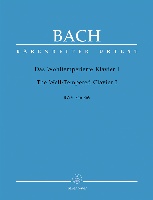Johann Sebastian Bach was a German composer, organist,
harpsichordist, violist, and violinist whose sacred and
secular works for choir, orchestra, and solo
instruments drew together the strands of the Baroque
period and brought it to its ultimate maturity.
Although he did not introduce new forms, he enriched
the prevailing German style with a robust contrapuntal
technique, an unrivalled control of harmonic and
motivic organisation, and the adaptation of rhythms,
forms and textures from abroad, p...(+)
Johann Sebastian Bach was a German composer, organist,
harpsichordist, violist, and violinist whose sacred and
secular works for choir, orchestra, and solo
instruments drew together the strands of the Baroque
period and brought it to its ultimate maturity.
Although he did not introduce new forms, he enriched
the prevailing German style with a robust contrapuntal
technique, an unrivalled control of harmonic and
motivic organisation, and the adaptation of rhythms,
forms and textures from abroad, particularly from Italy
and France.
The Fugue in D Minor (BWV 948) is one of the stranger
pieces in the Bach canon, excluding such obvious
pastiches as the Concerto e Fuga BWV 909. Nevertheless
it is included in NBA V/9.2 on the evidence of its
sources, which fall into three independent groups all
naming Bach (or at least 1. S. B.") as the composer.
None, however, is by an identified copyist close to
Bach, and the style, although seemingly from somewhere
in his orbit, does not point unequivocally to him. The
work is claimed to be early and based on "norddeutschen
Vorbildern" (NBA V/9.2, KB, 294), but there are no
models for its bizarre coda in the works of Reinken,
Bohm, or other north-German composers. Zehnder (1995,
332-3) groups the work with several others that he
assigns to the period 1709-11. One of these, the organ
praeludium in G minor BWV 535/1, includes the thing
closest in Bach's output to the cadenza at the end of
BWV 948, which takes it around the entire circle of
fifths (cf. BWV 535/1, mm. 19-32). But the stylistic
affinities between these pieces are superficial, even
if the present subject, consisting of a short motto
followed by sequential figuration, resembles others in
Bach's early fugues. One full measure of the subject
(m. 4) arpeggiates a single dominant-ninth harmony, a
type of gesture that seems relatively late. Odd things
happen in the second half of the piece, where a
near-verbatim recapitulation of the first exposition
(mm. 45-52116-9 + 11b-15a) is interrupted by a short,
unmotivated cadenza in A minor (m. 53). Up to here the
fugue has been in three parts, but a fourth voice now
enters, seemingly requiring pedals; the new voice does
not state the subject until m. 62b. Shortly afterwards
comes a second, much more lengthy cadenza that passes
mechanically through the circle of fifths on its way to
a motivically unrelated close." Even apart from the
ending, the unimaginative counterpoint, which
accompanies the sequences of the subject in routine
eighths and quarters, would place Bach's authorship in
doubt. Measures 65-6 are virtually unplayable even with
pedals. It is conceivable that, like the prelude to the
Suite BWV 815a, BWV 948 represents an experimental
stage of a piece that was never brought to final form;
perhaps it was finished by someone other than Bach.
.
Sources: D B Mus. ms. 10580; P 487; LEu N.1. 10338 (M.
pr. Ms. 20'); US NHy LM 4941; Gb. Editions: BG 36;
Dadelsen and Riinnau (1970), NBA V/9.2.
Although originally written for Harpsichord. I created
this Arrangement of the Fugue in D Minor (BWV 948) for
Concert (Pedal) Harp.





 Faire un don
Faire un don